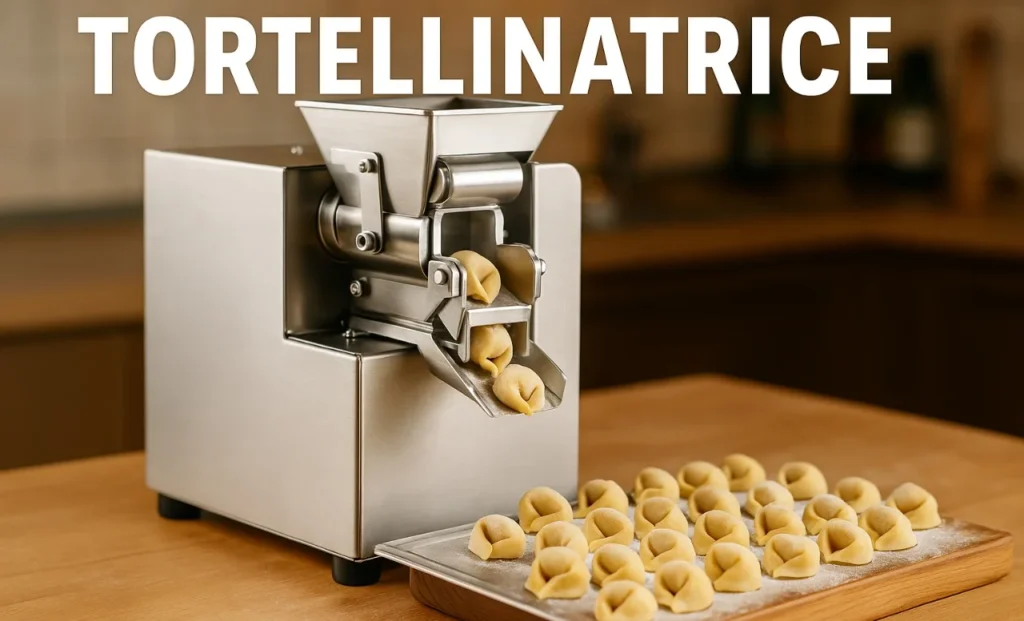The art of pasta making is deeply embedded in Italian tradition, with each region boasting its own variations and techniques. Among the many types of pasta, tortellini hold a special place—delicate, ring-shaped, and often filled with rich combinations of meat, cheese, or vegetables. But behind the scenes of mass production and artisanal replication lies a crucial invention: the tortellinatrice. This machine has not only streamlined the creation of tortellini but also preserved the craftsmanship of Italian culinary heritage in a modern world.
What Is a Tortellinatrice?
A tortellinatrice is a specialized pasta machine designed to automatically form tortellini, a traditional Italian stuffed pasta. The name comes from “tortellini” (the pasta) and the Italian suffix “-atrice,” denoting a machine or device. Essentially, it’s a tortellini-making machine.
This ingenious device folds, shapes, and seals tortellini with remarkable speed and consistency, which would be nearly impossible to achieve by hand, especially in large quantities. Tortellinatrici (plural) can be used in restaurants, pasta shops, or factories, depending on their size and sophistication.
A Brief History of the Tortellini Tradition
To understand the importance of the tortellinatrice, we must first explore the history of tortellini itself. Originating from the Emilia-Romagna region, particularly Bologna and Modena, tortellini are a source of pride for many Italians. Legend says that the pasta shape was inspired by the navel of Venus, the goddess of love.
Traditionally, making tortellini is a labor-intensive process involving rolling fresh pasta dough into thin sheets, cutting it into squares, placing small amounts of filling in the center, and then folding and twisting each piece into its iconic ring shape. While this process is beautiful, it is also time-consuming, which led to the invention of the tortellinatrice.
The Engineering Behind the Machine
The tortellinatrice may look simple on the outside, but inside it is a marvel of engineering. It typically includes a pasta sheet feeder, a filling injector, folding arms, and sealing components. More advanced versions also allow for adjustments in size, shape, and filling type.
Some machines work with fresh dough, while others are adapted to semi-dry or pre-made pasta sheets. The filling system is usually pressurized to ensure even distribution, and the cutter ensures that each tortellino is consistent in weight and size. This level of precision is especially important in commercial kitchens and factories.
Benefits of Using a Tortellinatrice
1. Efficiency and Speed
The most obvious advantage is speed. A trained chef might make a few dozen tortellini in an hour; a tortellinatrice can produce hundreds or even thousands, depending on the model. This is crucial for businesses needing to meet high demand without sacrificing quality.
2. Consistency
Handmade tortellini can vary in size and seal strength. Machines ensure uniformity, reducing the risk of the pasta opening during cooking or being underfilled.
3. Reduced Labor Costs
In a professional setting, automating the pasta-making process can significantly reduce the need for manual labor, which saves on costs while maintaining output.
4. Scalability
Whether you’re a small restaurant looking to expand production or a factory shipping tortellini across the globe, a tortellinatrice offers scalable solutions that can grow with your business.
Types of Tortellinatrici
Manual Tortellinatrici
Ideal for small kitchens or home chefs who still want some mechanical help without giving up full control. These machines require manual feeding and operation but offer greater precision than working entirely by hand.
Semi-Automatic Machines
Used by small to medium businesses, these require some manual oversight but automate most of the key processes—such as filling, folding, and cutting.
Fully Automatic Machines
Designed for industrial use, fully automatic tortellinatrici can produce tortellini around the clock with minimal supervision. They often come with programmable settings for different recipes and sizes.
Preserving Tradition in a Modern World
While some purists argue that pasta should always be made by hand, many chefs and pasta makers see the tortellinatrice as a bridge between tradition and innovation. In fact, using the machine does not necessarily mean compromising on quality. The dough and filling are still made from fresh, high-quality ingredients—the machine simply ensures that they are formed quickly and consistently.
Moreover, in an era when culinary heritage risks being lost to fast food and pre-packaged meals, the tortellinatrice allows small and medium producers to stay competitive without abandoning their roots.
Choosing the Right Tortellinatrice
If you’re considering investing in a tortellinatrice, here are a few key factors to consider:
-
Production Capacity: How many tortellini do you need to produce per hour?
-
Machine Size: Do you have enough kitchen or factory space?
-
Dough and Filling Compatibility: Make sure the machine works with your preferred ingredients.
-
Ease of Cleaning: Hygiene is critical in food production, so choose a model that’s easy to disassemble and sanitize.
-
Budget: Prices can vary from a few hundred to tens of thousands of euros.
A Future Shaped Like a Ring
The tortellinatrice is more than just a pasta machine—it’s a symbol of how technology can enhance, rather than erase, cultural traditions. By bringing efficiency to the ancient craft of tortellini-making, it helps ensure that this beloved dish remains a staple in homes and restaurants around the world.
Whether you’re a chef, a food entrepreneur, or simply a pasta enthusiast, the tortellinatrice is a testament to the perfect marriage of heritage and innovation. And in the world of Italian cuisine, that’s something to celebrate.


